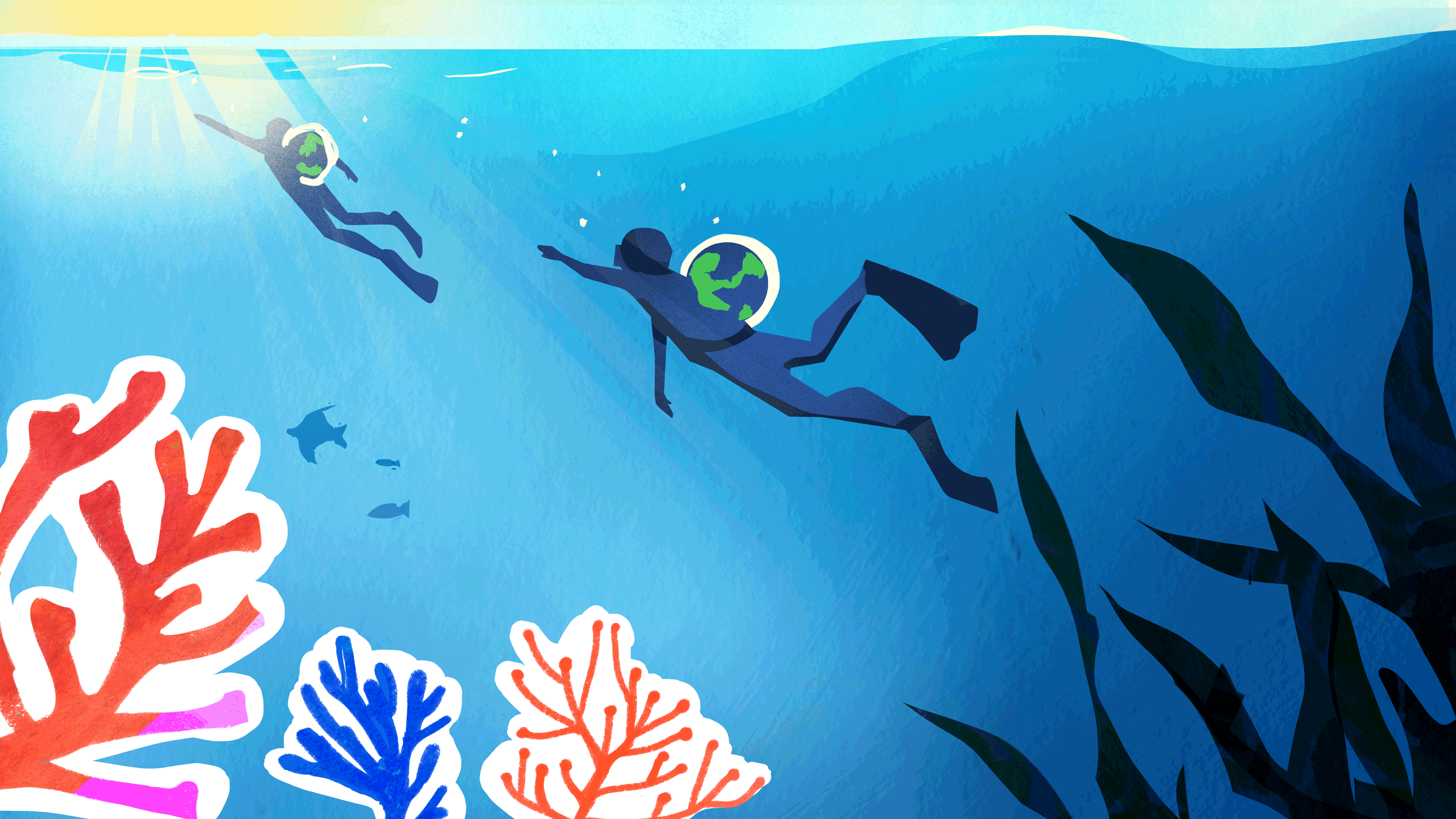
Imagine what you like. Now imagine that it is threatened.
That’s what Jada Alexander experienced while studying coral reefs in French Polynesia. As a student at the University of California, Santa Barbara, she was hooked on her first trip. “The reef was vibrant. It was beautiful,” she recalls. It was full of life and lots of crabs and fish.
But on the return trip a year later, much of the reef appeared to be dead. “It was dull and gray,” she said, which left her feeling hopeless.
Alexander is not alone. Survey data shows that more than half of young people feel anxious, angry, helpless, and helpless about human-induced climate change.
“If young people don’t have the desire to participate in climate action, it’s going to be much harder to reverse climate change,” said Elissa Eppel, a leading stress researcher at the University of California, San Francisco.
So she and a group of colleagues developed a new course called “Climate Resilience” and offered it for the first time on several UC campuses last spring. The goal is to turn students’ anguish about climate into collective action. Alexander enrolled in classes and became a teaching assistant.
This course offers inspiring lectures from scientists and leaders of the climate movement, presenting counter-narratives to despair and darkness. Eppel says many of us live in an “information bubble” that can be devastating. We are bombarded with negative stories of record heat, hurricanes, floods, and wildfires. The challenges are real, but so are the potential solutions.

And importantly, this course teaches resilience and coping skills, including mindfulness meditation, to empower students.
“There’s an arc, or a process, that guides people out of their dark inner worlds where they feel alone and separated,” Eppel says.
People who feel negative and hopeless are more likely to disengage or walk away.
“The great Zen master Thich Nhat Hanh said the exit is within,” she says. To transcend fear and anger, we need to practice compassion towards ourselves as well as others.
“Students come in very skeptical,” says Jyoti Mishra, a neuroscientist at the University of California, San Diego and co-director of the course. But by the end of the class, she says she sees a shift in many people’s thinking. When people feel positive, it’s easier to imagine themselves being part of the solution.
The post-class survey was very popular, and the course will be offered at 10 UC campuses next spring.
Philip Goldin, a clinical neuroscientist and co-leader of the climate resilience course at the University of California, Davis, said students felt a greater sense of belonging and a belief that they could “work with others” on climate change. It is reported that

Students in the course took action. We worked on community gardens focused on sustainable agriculture, waste reduction workshops, and recycling projects focused on clothing. After graduating, Jada Alexander is now working on integrating surfing and environmental management.
Although Alexander knows the solutions are complex and still has concerns about the planet, “I think this class has improved my ability to be a part of the solution.” she says.
Epel said the techniques and exercises taught in the class are “universal skills” that can help people deal with stress arising from all types of situations. If you want to try it out, here are some strategies based on this course.
1. Spend some quiet time and relax.

If we want to stay involved in the world’s problems, we have to start with our own well-being.
When you stop, look at the present, and let go of your worries, it’s an opportunity for a quick reset.
In your daily life, you can look for tips to slow down or create new rituals. For example, if a church, town hall, or campus bell is ringing, you can use that as a break. Or you can set reminders on your phone to take breaks throughout the day.
“There are all sorts of cues and cues that remind you to stop and breathe,” says Diana Hill, a clinical psychologist who teaches the course at the University of California, Santa Barbara. Focusing on your breathing activates your parasympathetic nervous system, making your body feel more at ease.
If you’d like to try a longer self-care pause, here’s a nature meditation used in meditation teacher Mark Coleman’s course.
2. Just like me: Look into the eyes of a stranger
In the class, participants are asked to choose a partner, usually a stranger. You will then be asked to look into each other’s eyes as you are guided through a guided meditation. “This may be uncomfortable,” Hill says, so it’s okay to close your eyes.
You can use this recording by Jack Kornfield as a guide.
“This person was once a little kid just like me. This person has had happy times just like me,” it begins.
This exercise is intended to help people realize how much they have in common with all human beings, even strangers and people who see the world differently.
“This person is hurting just like I am. This person experiences physical pain just like I do. This person wants to be loved just like I do. ”
The meditation ends by asking you to think of a happy moment for your partner and send the message, “I know you want to be happy, just like I do.”
This practice of understanding our common humanity is very powerful, says Hill.
You can also use Just Like Me Exercise with someone you have a difficult relationship with. Even if they aren’t sitting across from you, you can imagine yourself looking at them.
3. Respect the pain of others: It’s okay to cry.

“To be an activist for any cause, we need to work together, and that starts with expressing our grief,” Eppel said. This course incorporates a practice called “Honoring our Pain” by Joanna Macy and Molly Brown and takes approximately 15 minutes to complete.
Find a friend to try this out with. Please take your turn to express your concerns. Start with the prompt, “What concerns me most about today’s world and society is…” When one person speaks, the other person listens.
People think no one wants to hear thoughts of depression or sadness, Epel says. “But we need to talk about it. We need to process this very heavy feeling of grief.”
Learn the key points here. Listening is a gift. “The quality of our ability to really listen and pay attention to others is an act of compassion,” says Goldin.
In these conversations, he says, “you experience your own emotions, you deal with your own emotions and the emotions of others, and you begin to feel a sense of trust.”
As you repeat this, you will truly understand what is possible when you trust and stick with people. “It’s very powerful,” Goldin says.
4. Joy spreads, and so do complaints.

Partner again! It takes about 10 minutes, with each person speaking for half of the time. You have two minutes to complain. It can be a stream of consciousness frustration session – everything that’s bothering you, everything that’s wrong!
Notice how it feels to let it all out. Now flip the script.
Spend the next two minutes talking about what brings you joy. What brings you happiness today? What are you grateful for at this moment? A recent study found that people who were taught to practice gratitude had better mental health and fewer symptoms of anxiety and depression.
“I remember this exercise clearly,” Alexander says. When people complained, negative energy quickly spread. Then, when they switched to gratitude, there was a noticeable change. “People were laughing and smiling and there was such a vibrant energy throughout the room,” she says.
5. Write a love letter to the earth

Why not take a short walk outside? 5 or 10 minutes is enough. Or just sit quietly in your favorite spot outdoors. Think of it as a small nature retreat to connect with the natural world. Once you are relaxed, you can write down your thoughts and start writing the letter. Here are some quick-answer questions borrowed from the class.
What was your experience in nature like? Have you ever felt love?
Epel says allowing yourself to feel love and gratitude for the Earth can evoke strong emotions, so let go and sink into the stillness. Check out Vietnamese Buddhist monk Thich Nhat Hanh’s love letter to the Earth to help you get started.
6. Letter to your future self
Writing a letter to your future self is an exercise in “gaining perspective,” says Hill. It’s a way to shift your focus away from current conflicts and stressors and toward all potential opportunities.
First, imagine yourself in the future, whether it’s 1 year or 20 years from now. What do you want for yourself? Where do you want to be? What hurdles have you overcome?

Maybe we can see a future where the climate crisis is solved and we work with others to work on solutions to specific problems. Once you have that future in mind, you can start thinking about specific goals and steps to take to get there. “It’s very motivating,” Hill says.
Another option is to write a letter to your future self asking what will happen if you don’t help solve the problem. “If you focus on the pain and discomfort of what would happen if you didn’t do something, that can also be a motivator,” says Hill.
The editors of Stress Less are Carmel Wroth and Jane Greenhalgh.
#Heres #turn #climate #change #fears #action